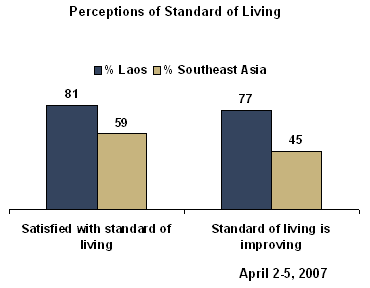Despite Struggling Economy, Extreme Optimism in Laos
GALLUP NEWS SERVICE
PRINCETON, NJ -- In the Southeast Asian country of Laos, per-capita income is staggeringly low, the workforce is largely agrarian, and depleted reserves have resulted in the need for hefty loans to finance domestic development projects. But despite these gloomy economic indicators, Laotians express a great deal of enthusiasm about economic conditions in their nation.
Laos is one of the last remaining Communist countries in the world. The communist government came to power in 1975, designing an economic framework that mirrored the planned economy of the Soviet Union and included an emphasis on state-owned enterprises and barriers to trade. It did not take long for these fiscal policies to damage the economy. In 1986, the Lao government introduced reforms that included market-based pricing of goods, growth of the private sector, private ownership of farmland, and the lifting of trade barriers.
The government reforms spurred considerable economic expansion; growth rates have averaged 6% since 1988. However, Laos' per-capita GDP of $2,100 remains among the lowest in the region second to Myanmar's $1,800, the nation's debt totals more than $3 billion (in U.S. currency), and approximately 80% of the workforce relies on subsistence farming -- even though only 5% of the land is capable of cultivation.
In spite of the economic indicators, the people of Laos display remarkable enthusiasm when asked for their perceptions of the economy. Approximately 8 in 10 Laotians say they are satisfied with their current standard of living, and more than three-fourths (77%) say their standard of living is improving. About 9 in 10 feel the current economic conditions in Laos are good (89%) and that those conditions are getting better (90%).

This level of economic optimism is considerably higher than the regional results for all of Southeast Asia, which include the new "Asian Tiger" countries of Indonesia, Malaysia, the Philippines, Thailand, and Vietnam. Only 6 in 10 (59%) Southeast Asians are happy with their current standard of living, and less than half (45%) feel it is getting better.
Laotians' unusual exuberance seems particularly tuned to economic conditions; when it comes to a broader measure of optimism, results are more similar to those of neighboring countries.
Survey Methods
These results are based on face-to-face interviews with a randomly selected national sample of 1,002 Laotians, aged 15 and older, conducted during July 2006. For results based on this sample, one can say with 95% confidence that the approximate error attributable to sampling and other random effects is ±3 percentage points. In addition to sampling error, question wording and practical difficulties in conducting surveys can introduce error or bias into the findings of public opinion polls.


